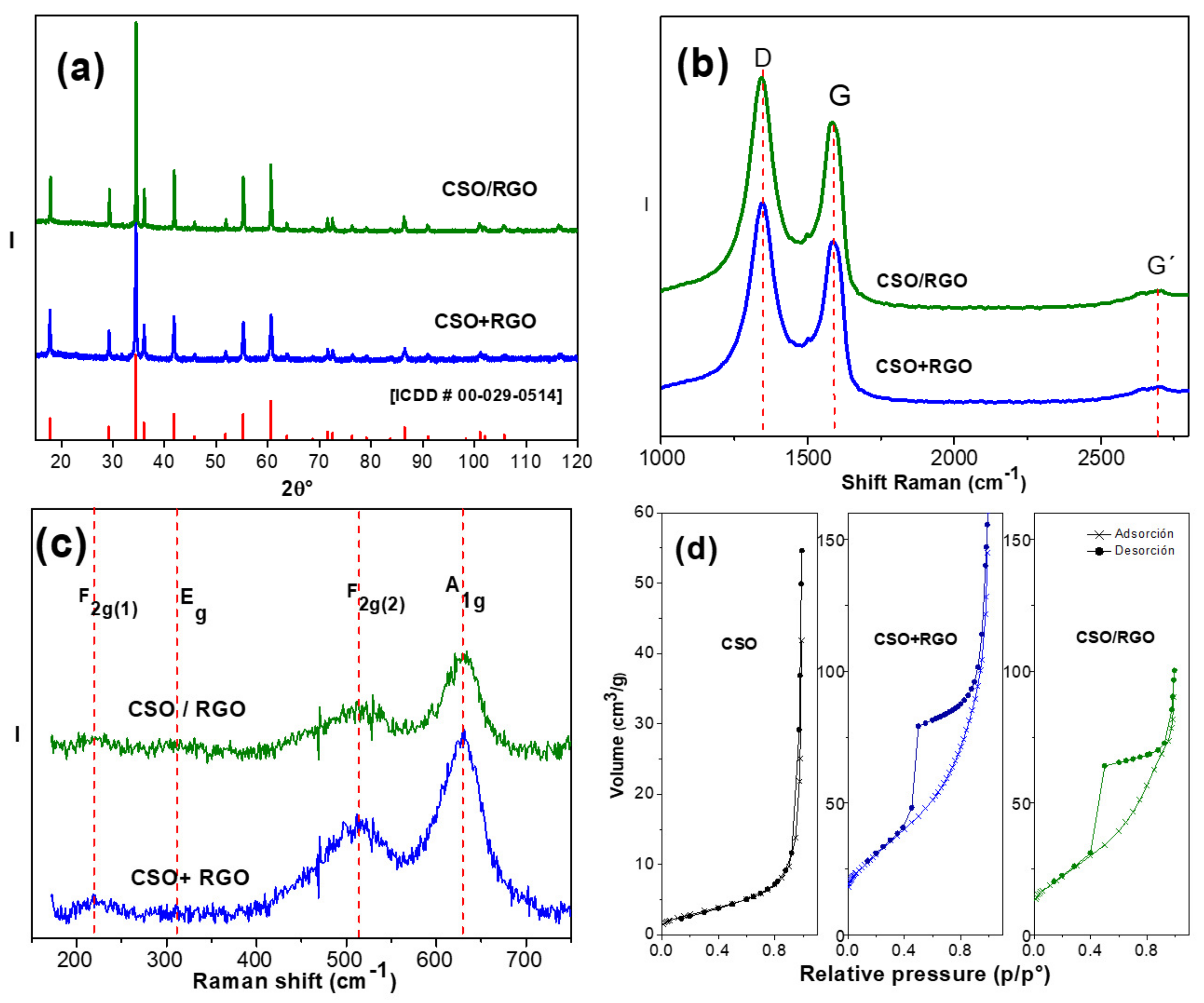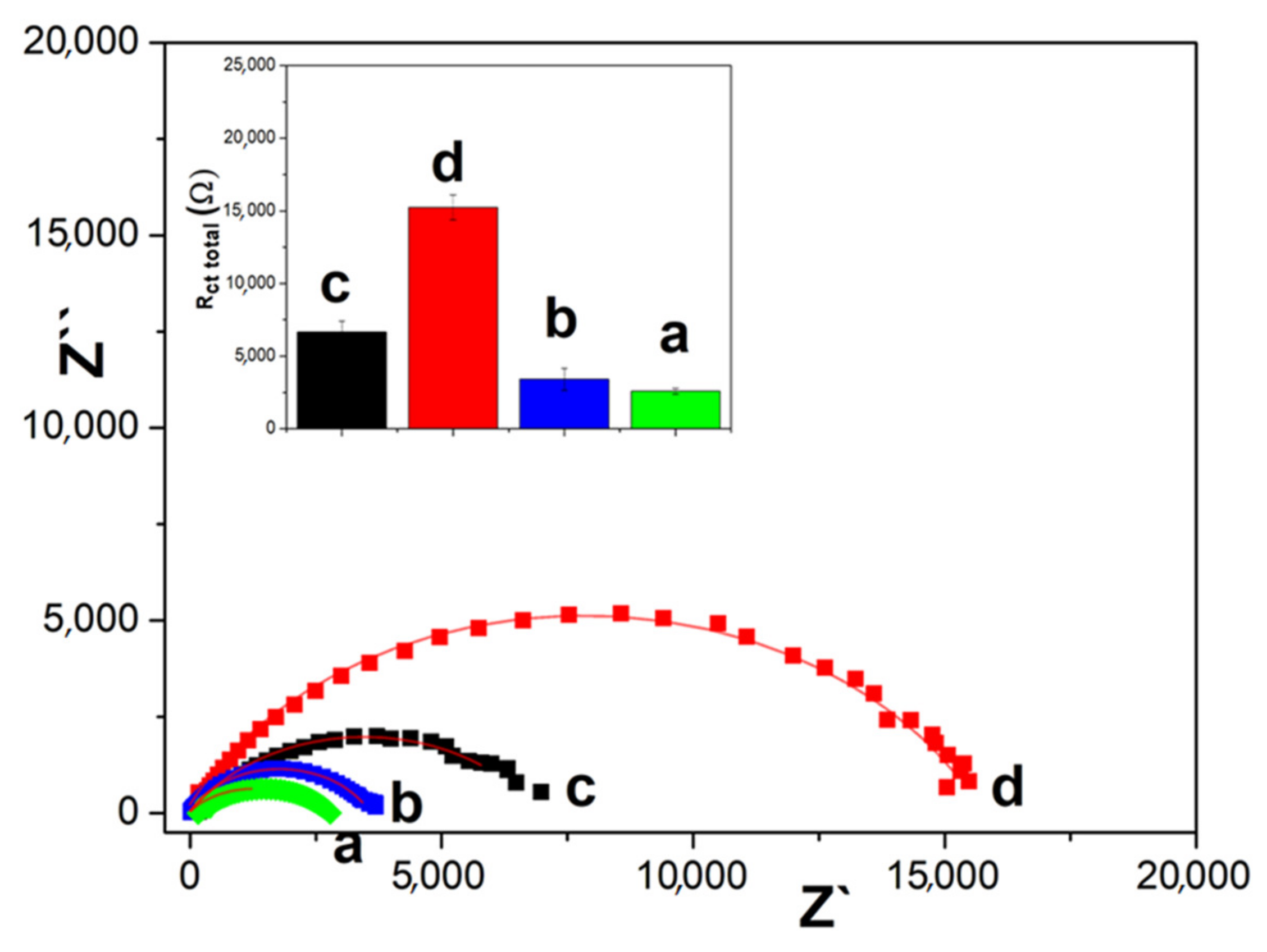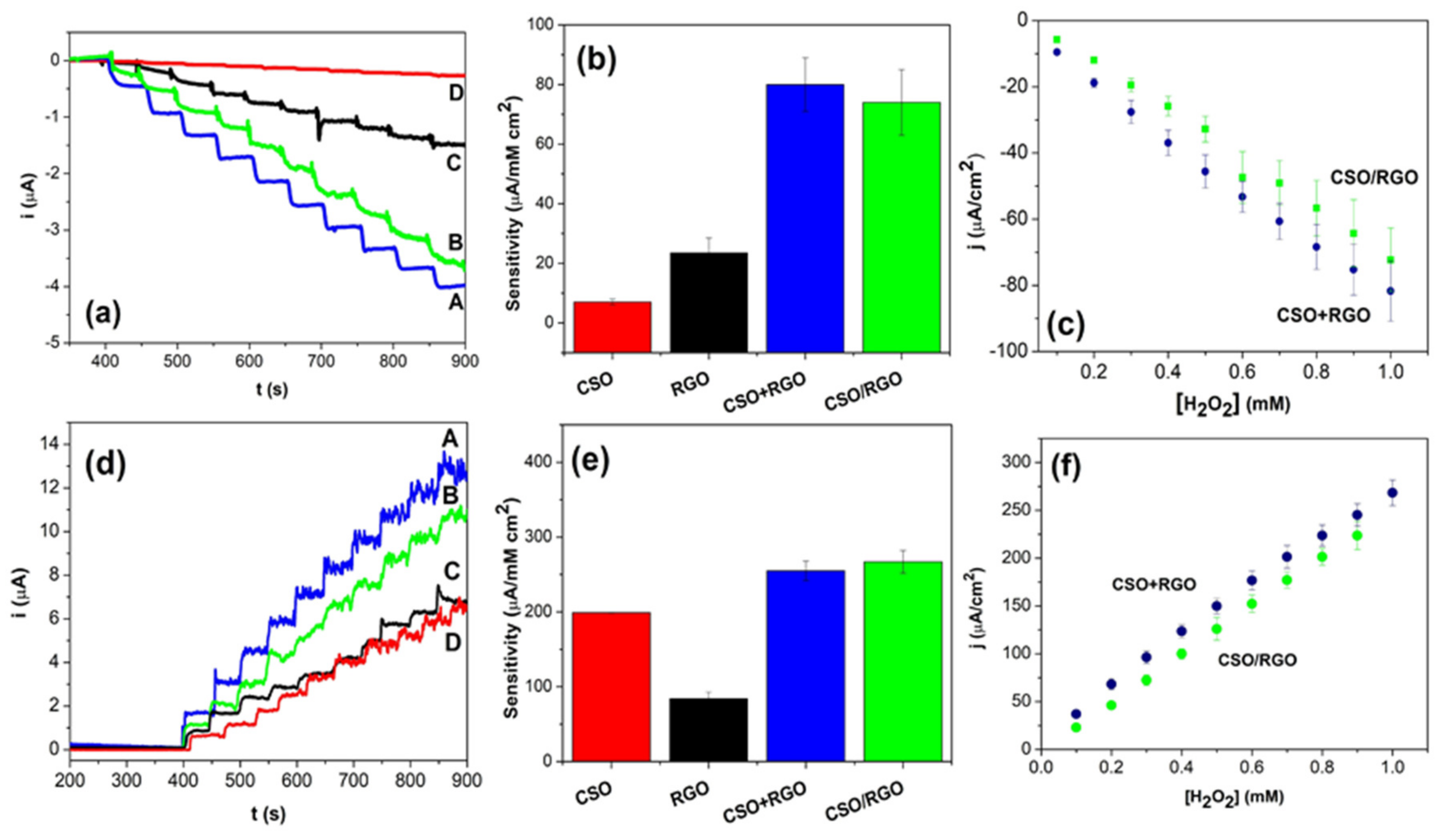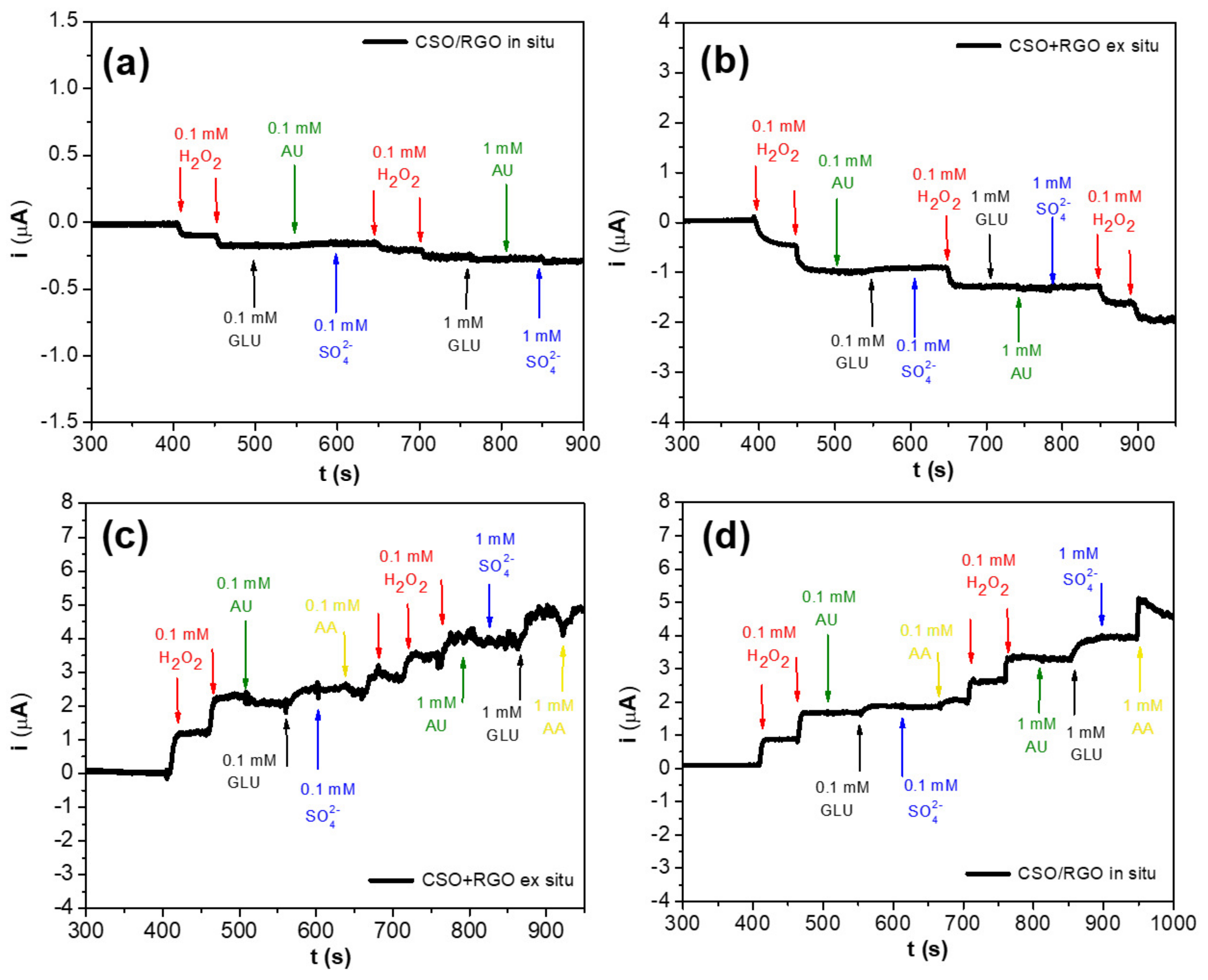In situ or Ex situ Synthesis for Electrochemical Detection of Hydrogen Peroxide—An Evaluation of Co2SnO4/RGO Nanohybrids
Abstract
1. Introduction
2. Materials and Methods
2.1. Chemical Reagents
2.2. Synthesis of the Nanohybrids
2.3. Modification of Glassy Carbon Electrodes (GCEs) with Hybrid Nanomaterials
2.4. Characterization
3. Results and Discussion
3.1. Characterization of CSO/RGO and CSO+RGO Hybrid Nanomaterials
3.2. Electrochemical Characterization of Modified Glassy Carbon Electrodes with Hybrid Nanomaterial CSO/RGO and CSO+RGO
3.3. Amperometric H2O2 Detection
4. Conclusions
Supplementary Materials
Author Contributions
Funding
Conflicts of Interest
References
- Aguilar-Martínez, J.A.; Pech-Canul, M.I.; Esneider, M.; Toxqui, A.; Shaji, S. Synthesis, Structure Parameter and Reaction Pathway for Spinel-Type Co2SnO4. Mater. Lett. 2012, 78, 28–31. [Google Scholar] [CrossRef]
- Navrotsky, A.; Kleppa, O.J. The Thermodynamics of Cation Distributions in Simple Spinels. J. Inorg. Nucl. Chem. 1967, 29, 2701–2714. [Google Scholar] [CrossRef]
- Venegas, C.J.; Gutierrez, F.A.; Eguílaz, M.; Marco, J.F.; Reeves-McLaren, N.; Rivas, G.A.; Ruiz-León, D.; Bollo, S. Co2TiO4/Reduced Graphene Oxide Nanohybrids for Electrochemical Sensing Applications. Nanomaterials 2019, 9, 1611. [Google Scholar] [CrossRef] [PubMed]
- Sundararaj, S.B.; Tamilarasan, S.; Thangavelu, S. Layered Porous Graphitic Carbon Nitride Stabilized Effective Co2SnO4 Inverse Spinel as a Bifunctional Electrocatalyst for Overall Water Splitting. Langmuir 2022, 38, 7833–7845. [Google Scholar] [CrossRef]
- Gnana Sundara Raj, B.; Bhuvaneshwari, S.; Wu, J.J.; Asiri, A.M.; Anandan, S. Sonochemical Synthesis of Co2SnO4 nanocubes for Supercapacitor Applications. Ultrason. Sonochem. 2018, 41, 435–440. [Google Scholar] [CrossRef]
- Chen, C.; Ru, Q.; Hu, S.; An, B.; Song, X.; Hou, X. Co2SnO4 Nanocrystals Anchored on Graphene Sheets as High-Performance Electrodes for Lithium-Ion Batteries. Electrochim. Acta 2015, 151, 203–213. [Google Scholar] [CrossRef]
- Bouchaaba, H.; Bellal, B.; Maachi, R.; Trari, M.; Nasrallah, N.; Mellah, A. Optimization of Physico-Chemical Parameters for the Photo-Oxidation of Neutral Red on the Spinel Co2SnO4. J. Taiwan Inst. Chem. Eng. 2016, 58, 310–317. [Google Scholar] [CrossRef]
- Wang, C.; Jiang, L.; Wang, J.; Liu, F.; You, R.; Lv, S.; Yang, Z.; He, J.; Liu, A.; Yan, X.; et al. Mixed Potential Type H2S Sensor Based on Stabilized Zirconia and a Co2SnO4 Sensing Electrode for Halitosis Monitoring. Sensors Actuators B Chem. 2020, 321, 128587. [Google Scholar] [CrossRef]
- Hwa, K.Y.; Santhan, A.; Sharma, T.S.K. One-Dimensional Self-Assembled Co2SnO4 Nanosphere to Nanocubes Intertwined in Two-Dimensional Reduced Graphene Oxide: An Intriguing Electrocatalytic Sensor toward Mesalamine Detection. Mater. Today Chem. 2022, 23, 100739. [Google Scholar] [CrossRef]
- Masjedi-Arani, M.; Salavati-Niasari, M. Ultrasonic Assisted Synthesis of a Nano-Sized Co2SnO4/Graphene: A Potential Material for Electrochemical Hydrogen Storage Application. Int. J. Hydrogen Energy 2018, 43, 4381–4392. [Google Scholar] [CrossRef]
- Venegas, C.J.; Yedinak, E.; Marco, J.F.; Bollo, S.; Ruiz-León, D. Co−doped Stannates ⁄reduced Graphene Composites: Effect of Cobalt Substitution on the Electrochemical Sensing of Hydrogen Peroxide. Sens. Actuators B Chem. 2017, 250, 412–419. [Google Scholar] [CrossRef]
- Yedinak, E.; Venegas, C.J.; Brito, T.P.; Ruiz-León, D.; Bollo, S. Co2SnO4/Carbon Nanotubes Composites: A Novel Approach for Electrochemical Sensing of Hydrogen Peroxide. Electroanalysis 2018, 30, 27–30. [Google Scholar] [CrossRef]
- Mubasher; Mumtaz, M.; Ali, B.; Abbas, S.M.; Nam, K.-W.; Khan, M.T.; Ali, M.; Hussain, B.; Khan, M.M.; Mehmood, G. Nanohybrids of Hematite Nanoparticles and Reduced Graphene Oxide Nanosheets: Anode Materials for Lithium Ion Batteries. J. Alloys Compd. 2022, 907, 164392. [Google Scholar] [CrossRef]
- Roostaee, M.; Beitollahi, H.; Sheikhshoaie, I. Simultaneous Determination of Dopamine and Uric Acid in Real Samples Using a Voltammetric Nanosensor Based on Co-MOF, Graphene Oxide, and 1-Methyl-3-Butylimidazolium Bromide. Micromachines 2022, 13, 1834. [Google Scholar] [CrossRef]
- Guan, Y.; Liu, L.; Yu, S.; Lv, F.; Guo, M.; Luo, Q.; Zhang, S.; Wang, Z.; Wu, L.; Lin, Y.; et al. A Noninvasive Sweat Glucose Biosensor Based on Glucose Oxidase/Multiwalled Carbon Nanotubes/Ferrocene-Polyaniline Film/Cu Electrodes. Micromachines 2022, 13, 2142. [Google Scholar] [CrossRef]
- Khorrambin, S.; Ghasemi, S.; Hosseini, S.R. Ultrasonically Assisted Preparation of Molybdenum Sulfide/Graphitic Carbon Nitride Nanohybrid as Counter Electrode Material for Dye-Sensitized Solar Cell. J. Alloys Compd. 2022, 929, 167220. [Google Scholar] [CrossRef]
- Zhou, K.; Zhu, Y.; Yang, X.; Li, C. One-Pot Preparation of Graphene/Fe3O4 Composites by a Solvothermal Reaction. New J. Chem. 2010, 34, 2950–2955. [Google Scholar] [CrossRef]
- Miao, X.; Ge, X.; Wang, P.; Zhao, D.; Yin, L. Size-Tunable SnO2/Co2SnO4 Nanoparticles Loaded 3D Reduced Graphene Oxide Aerogel Architecture as Anodes for High Performance Lithium Ion Batteries. Electrochim. Acta 2020, 356, 136769. [Google Scholar] [CrossRef]
- Báez, D.F.; Brito, T.P.; Espinoza, L.C.; Méndez-Torres, A.M.; Sierpe, R.; Sierra-Rosales, P.; Venegas, C.J.; Yáñez, C.; Bollo, S. Graphene-Based Sensors for Small Molecule Determination in Real Samples. Microchem. J. 2021, 167, 106303. [Google Scholar] [CrossRef]
- Bai, S.; Shen, X. Graphene—Inorganic Nanocomposites. RSC Adv. 2012, 2, 64. [Google Scholar] [CrossRef]
- Huang, X.; Qi, X.; Boey, F.; Zhang, H. Graphene-Based Composites. Chem. Soc. Rev. 2012, 41, 666–686. [Google Scholar] [CrossRef] [PubMed]
- Yan, W.; Bian, W.; Jin, C.; Tian, J.-H.; Yang, R. An Efficient Bi-Functional Electrocatalyst Based on Strongly Coupled CoFe2O4/Carbon Nanotubes Hybrid for Oxygen Reduction and Oxygen Evolution. Electrochim. Acta 2015, 177, 65–72. [Google Scholar] [CrossRef]
- Qi, Y.; Du, N.; Zhang, H.; Wu, P.; Yang, D. Synthesis of Co2SnO4@C Core-Shell Nanostructures with Reversible Lithium Storage. J. Power Sources 2011, 196, 10234–10239. [Google Scholar] [CrossRef]
- Toby, B.H. EXPGUI, a Graphical User Interface for GSAS. J. Appl. Crystallogr. 2001, 34, 210–213. [Google Scholar] [CrossRef]
- Mccusker, L.B.; Von Dreele, R.B.; Cox, D.E.; Louër, D.; Scardi, P. Rietveld Refnement Guidelines. J. Appl. Cryst. 1999, 32, 36–50. [Google Scholar] [CrossRef]
- Brunauer, S.; Emmett, P.H.; Teller, E. Adsorption of Gases in Multimolecular Layers. J. Am. Chem. Soc. 1938, 60, 309–319. [Google Scholar] [CrossRef]
- Krishnamoorthy, K.; Veerapandian, M.; Mohan, R.; Kim, S.-J. Investigation of Raman and photoluminescence studies of reduced graphene oxide sheets. Appl. Phys. A 2012, 106, 501–506. [Google Scholar] [CrossRef]
- Childres, I.; Jauregui, L.A.; Park, W.; Cao, H.; Chen, Y.P. Raman Spectroscopy of Graphene and Related Materials. In New Developments in Photon and Materials Research; Nova Publishers: New York, NY, USA, 2013; pp. 1–19. [Google Scholar]
- Malard, L.M.; Pimenta, M.A.; Dresselhaus, G.; Dresselhaus, M.S. Raman Spectroscopy in Graphene. Phys. Rep. 2009, 473, 51–87. [Google Scholar] [CrossRef]
- Araujo, P.T.; Terrones, M.; Dresselhaus, M.S. Defects and Impurities in Graphene-like Materials. Mater. Today 2012, 15, 98–109. [Google Scholar] [CrossRef]
- Konios, D.; Stylianakis, M.M.; Stratakis, E.; Kymakis, E. Dispersion Behaviour of Graphene Oxide and Reduced Graphene Oxide. J. Colloid Interface Sci. 2014, 430, 108–112. [Google Scholar] [CrossRef]
- Julien, C.M.; Massot, M. Lattice Vibrations of Materials for Lithium Rechargeable Batteries I. Lithium Manganese Oxide Spinel. Mater. Sci. Eng. B 2003, 97, 217–230. [Google Scholar] [CrossRef]
- D’Ippolito, V.; Andreozzi, G.B.; Bersani, D.; Lottici, P.P. Raman Fingerprint of Chromate, Aluminate and Ferrite Spinels. J. Raman Spectrosc. 2015, 46, 1255–1264. [Google Scholar] [CrossRef]
- Álvarez-Docio, C.M.; Reinosa, J.J.; Del Campo, A.; Fernández, J.F. Investigation of Thermal Stability of 2D and 3D CoAl2O4 Particles in Core-Shell Nanostructures by Raman Spectroscopy. J. Alloys Compd. 2018, 779, 244–254. [Google Scholar] [CrossRef]
- Mazarío, E.; Herrasti, P.; Morales, M.P.; Menéndez, N. Synthesis and Characterization of CoFe2O4 Ferrite Nanoparticles Obtained by an Electrochemical Method. Nanotechnology 2012, 23, 355708. [Google Scholar] [CrossRef]
- Cao, Q.; Shao, Z.; Hensley, D.K.; Lavrik, N.V.; Venton, B.J. Influence of geometry on thin layer and diffusion processes at carbon electrodes. Langmuir 2021, 37, 2667–2676. [Google Scholar] [CrossRef]
- Wang, M.; Ma, J.; Guan, X.; Peng, W.; Fan, X.; Zhang, G.; Zhang, F.; Li, Y. A Novel H2O2 Electrochemical Sensor Based on NiCo2S4 Functionalized Reduced Graphene Oxide. J. Alloys Compd. 2019, 784, 827–833. [Google Scholar] [CrossRef]
- Dinesh, M.; Revathi, C.; Haldorai, Y.; Rajendra Kumar, R.T. Birnessite MnO2 Decorated MWCNTs Composite as a Nonenzymatic Hydrogen Peroxide Sensor. Chem. Phys. Lett. 2019, 731, 136612. [Google Scholar] [CrossRef]
- Kaplan, S.; Suna Karatekin, R.; Kahya Dudukcu, M.; Avcı, G. A Novel Ni–Fe3O4@s-RGO/GCE Electrode for Electrochemical Detection of H2O2. Mater. Chem. Phys. 2023, 294, 127051. [Google Scholar] [CrossRef]





| Crystallite Size (nm) | Surface BET (m2/g) | Total Pore Volume (cm3/g) | Pore Size (nm) | C (10−5 F) | Rtc (Ω) | kET (10−4 cm s−1) | |
|---|---|---|---|---|---|---|---|
| CSO+RGO | 29.5 ± 4.8 | 109 | 0.243 | 47 ± 16 | 2.85 | 3491 ± 635 | 2.46 |
| CSO/RGO | 38.9 ± 7.8 | 82 | 0.152 | 31 ± 11 | 3.09 | 2589 ± 184 | 2.11 |
Disclaimer/Publisher’s Note: The statements, opinions and data contained in all publications are solely those of the individual author(s) and contributor(s) and not of MDPI and/or the editor(s). MDPI and/or the editor(s) disclaim responsibility for any injury to people or property resulting from any ideas, methods, instructions or products referred to in the content. |
© 2023 by the authors. Licensee MDPI, Basel, Switzerland. This article is an open access article distributed under the terms and conditions of the Creative Commons Attribution (CC BY) license (https://creativecommons.org/licenses/by/4.0/).
Share and Cite
Venegas, C.J.; Gutierrez, F.A.; Reeves-McLaren, N.; Rivas, G.A.; Ruiz-León, D.; Bollo, S. In situ or Ex situ Synthesis for Electrochemical Detection of Hydrogen Peroxide—An Evaluation of Co2SnO4/RGO Nanohybrids. Micromachines 2023, 14, 1059. https://doi.org/10.3390/mi14051059
Venegas CJ, Gutierrez FA, Reeves-McLaren N, Rivas GA, Ruiz-León D, Bollo S. In situ or Ex situ Synthesis for Electrochemical Detection of Hydrogen Peroxide—An Evaluation of Co2SnO4/RGO Nanohybrids. Micromachines. 2023; 14(5):1059. https://doi.org/10.3390/mi14051059
Chicago/Turabian StyleVenegas, Constanza J., Fabiana A. Gutierrez, Nik Reeves-McLaren, Gustavo A. Rivas, Domingo Ruiz-León, and Soledad Bollo. 2023. "In situ or Ex situ Synthesis for Electrochemical Detection of Hydrogen Peroxide—An Evaluation of Co2SnO4/RGO Nanohybrids" Micromachines 14, no. 5: 1059. https://doi.org/10.3390/mi14051059
APA StyleVenegas, C. J., Gutierrez, F. A., Reeves-McLaren, N., Rivas, G. A., Ruiz-León, D., & Bollo, S. (2023). In situ or Ex situ Synthesis for Electrochemical Detection of Hydrogen Peroxide—An Evaluation of Co2SnO4/RGO Nanohybrids. Micromachines, 14(5), 1059. https://doi.org/10.3390/mi14051059







